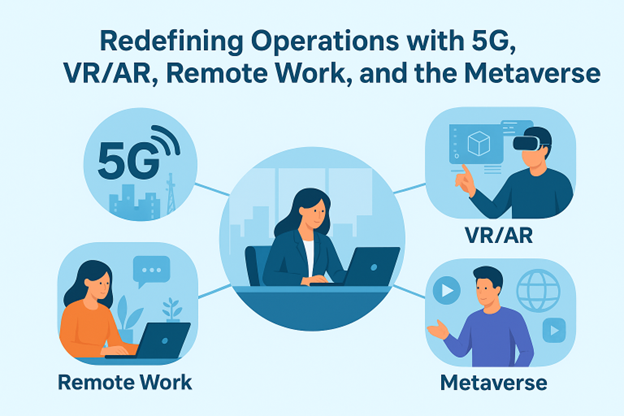Redefining Operations with 5G, VR/AR, Remote Work, and Metaverse

(Source: AI)
The rapid growth of digital technologies is changing the foundations of how organizations function. Today, four innovations—5G networks, Virtual and Augmented Reality (VR/AR), remote work platforms, and the metaverse—are converging to reshape operations in ways that were once unimaginable. Instead of existing as separate developments, these technologies reinforce one another, creating new ecosystems that enhance connectivity, efficiency, and collaboration across industries.
At the core of this transformation is 5G, which acts as the backbone of the digital workplace. Unlike previous generations of mobile networks, 5G is not only about speed; it is about reliability, capacity, and near-zero latency. This breakthrough allows industries to adopt technologies that rely on instant responsiveness, such as remote-controlled machinery in manufacturing, real-time monitoring of logistics fleets, or IoT-driven smart cities. For businesses, 5G makes it possible to run cloud-based platforms seamlessly, connect employees across regions without lag, and enable new levels of automation. In short, it lays the infrastructure that powers the next generation of work.
Building on this foundation, VR and AR technologies bring immersion into daily operations. Augmented Reality provides digital overlays that enhance physical tasks, for example, guiding a field technician step by step through a repair or enabling factory workers to visualize workflows in real time. Virtual Reality, on the other hand, creates entirely simulated spaces where teams can collaborate as if they were in the same room. Architects can design 3D models together, medical professionals can practice surgeries virtually, and companies can onboard new employees through interactive VR environments. This reduces the need for travel, speeds up learning, and fosters collaboration that feels tangible even when teams are physically apart.
The global shift toward remote work demonstrates how digital platforms are no longer optional but essential for survival. What started as a necessity during global crises has evolved into a permanent feature of modern organizations. Remote work systems allow companies to access talent globally, creating diverse and distributed teams that were previously out of reach. With project management applications, AI-driven scheduling assistants, and cloud collaboration tools, organizations ensure that productivity remains high regardless of location. This flexibility not only benefits employees, who gain better work-life balance, but also improves organizational resilience by reducing dependence on physical offices and central locations.
While remote work changes where employees operate, the metaverse is changing how they interact. The metaverse is a persistent, shared virtual environment where companies can establish digital headquarters, host immersive meetings, or build entirely new business models. Retail brands, for example, are experimenting with virtual stores where customers shop using avatars, while universities and training institutions are creating digital campuses for interactive learning. Healthcare providers can simulate treatments or run consultations in virtual clinics, expanding access to care. For businesses, the metaverse is not just a space for interaction, it is an opportunity to extend branding, deepen customer engagement, and create new revenue streams in digital economies.
The real power of these technologies emerges when they are integrated. 5G ensures the speed and connectivity needed for immersive VR/AR applications, while remote work frameworks provide the cultural and organizational shift toward flexible operations. The metaverse ties these elements together by offering a unified platform where digital collaboration becomes more natural and interactive. Instead of replacing physical workplaces, this hybrid model blends the digital and physical, enabling companies to operate with unprecedented agility.
This convergence also signals a broader transformation of business strategy. Organizations are no longer only competing on products or services; they are competing with their ability to create digital-first operational ecosystems. Companies that adopt these tools early are more likely to innovate faster, attract global talent, and build customer loyalty in new ways. Those that resist may find themselves limited by outdated infrastructures and cultural models that no longer match the pace of technological change.
In conclusion, the future of operations lies at the intersection of connectivity, immersion, flexibility, and virtual environments. 5G provides the technical backbone, VR/AR deliver immersive collaboration, remote work ensures adaptability, and the metaverse opens doors to entirely new ways of engaging with stakeholders. As these technologies continue to mature, they will not simply enhance existing workflows but will fundamentally redefine how organizations create value, connect with people, and imagine the future of work. Businesses that embrace this convergence today will position themselves as leaders in tomorrow’s digital economy.
Reference:
- (2025). Top Trends 2025 by Industry Experts. Retrieved from emeritus.org
- (2024). How AI agents, synthetic data, and executive literacy build resilient organizations. Retrieved from techradar.com
- (2025). Top 5 Manufacturing Trends to Watch in 2025. Retrieved from incit.org
- Globis Insights. (2025). Top 5 Business Trends for 2025. Retrieved from globisinsights.com
- LinkedIn Pulse. (2025). Emerging Industries to Watch in 2025. Retrieved from linkedin.com




Comments :